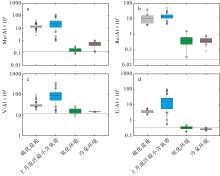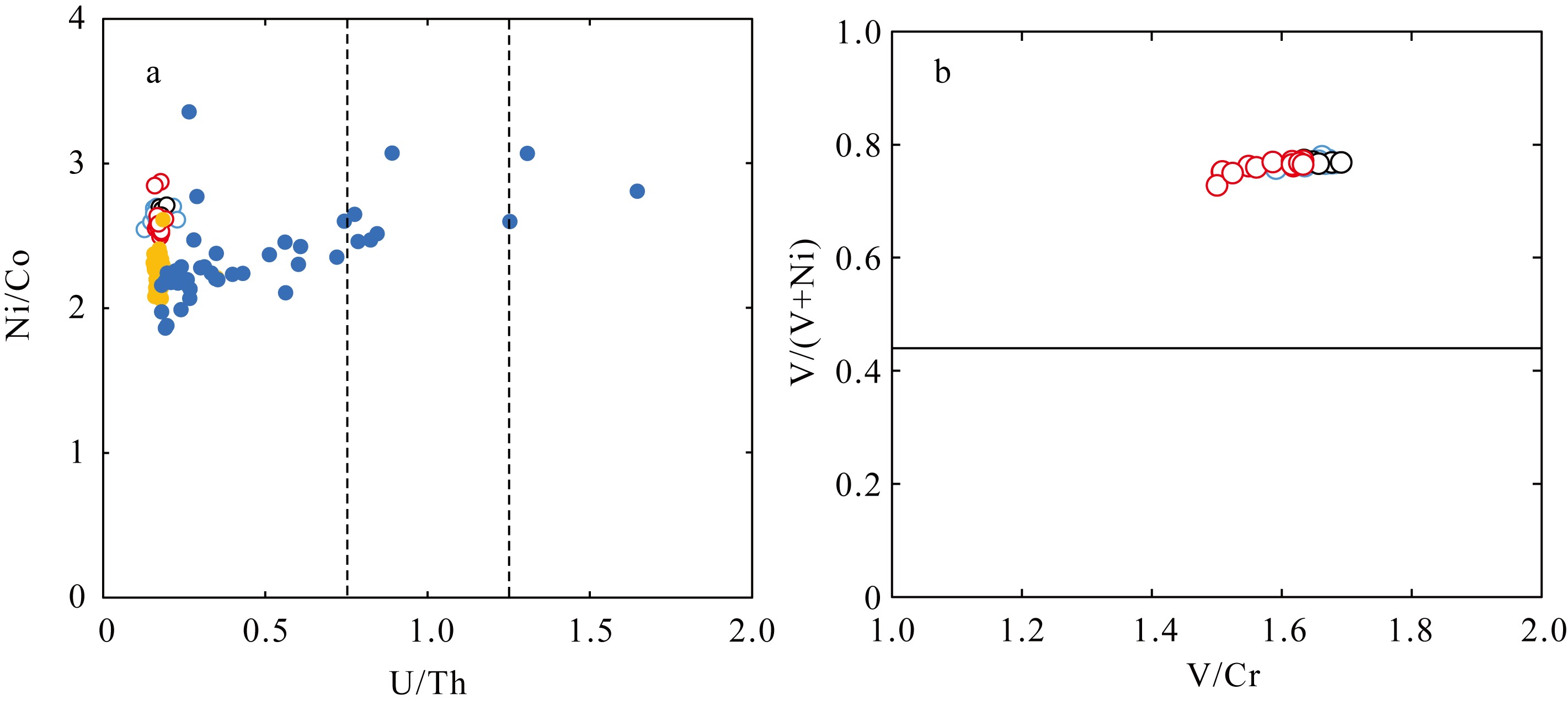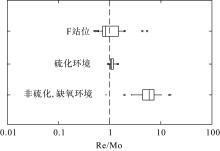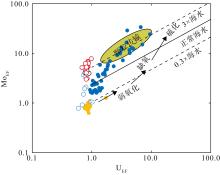Journal of Tropical Oceanography ›› 2023, Vol. 42 ›› Issue (5): 144-153.doi: 10.11978/2022224CSTR: 32234.14.2022224
• Marine Geology • Previous Articles Next Articles
The impact of cold seepage on geochemical indices for redox conditions of marine sediments ―Site F active seep site in the northeastern South China Sea*
LI Niu1,2( ), DI Pengfei1,2, FENG Dong3, CHEN Duofu3
), DI Pengfei1,2, FENG Dong3, CHEN Duofu3
- 1. Key Laboratory of Ocean and Marginal Sea Geology, South China Sea Institute of Oceanology, Innovation Academy of South China Sea Ecology and Environmental Engineering, Chinese Academy of Sciences, Guangzhou 510301, China
2. Southern Marine Science and Engineering Guangdong Laboratory (Guangzhou), Guangzhou 511458, China
3. Shanghai Engineering Research Center of Hadal Science and Technology, College of Marine Sciences, Shanghai Ocean University, Shanghai 201306, China
-
Received:2022-10-21Revised:2022-12-25Online:2023-09-10Published:2023-03-14 -
Supported by:National Natural Science Foundation of China(41976061)
Cite this article
LI Niu, DI Pengfei, FENG Dong, CHEN Duofu. The impact of cold seepage on geochemical indices for redox conditions of marine sediments ―Site F active seep site in the northeastern South China Sea*[J].Journal of Tropical Oceanography, 2023, 42(5): 144-153.
share this article
Add to citation manager EndNote|Reference Manager|ProCite|BibTeX|RefWorks
Tab. 1
Division of redox conditions and identification indicators of redox conditions of marine waters, modified from LYU et al (2021)"
| 指标 | 氧化环境 | 次氧化环境 | 缺氧环境(无H2S) | 硫化环境 |
|---|---|---|---|---|
| O2/(mL·L-1) | >2.0 | 0.2~2.0 | <0.2 | 0 |
| H2S/(mL·L-1) | 0 | 0 | 0 | >0 |
| Mo/(μg·g-1) | >100 | |||
| U/Th | <0.75 | 0.75~1.25 | >1.25 | |
| Ni/Co | <5 | 5~7 | >7 | |
| V/Cr | <2 | 2~4.25 | >4.25 | |
| V/(V+Ni) | <0.45 | 0.45~0.60 | 0.54~0.82 | >0.84 |
| MoEF /UEF | (0.1~0.3)×SW | (1~3)×SW | (3~10)×SW | |
| Re/Mo | <0.3×10-3 | >0.77×10-3 | 接近 0.77×10-3 |
Tab. 3
Major and trace element contents and ratios in seep site F sediments of the northern South China Sea"
| 柱样名称 | 深度/cm | Al2O3/% | MnO/% | Re/ (μg·g-1) | Mo/ (μg·g-1) | U/ (μg·g-1) | V/ (μg·g-1) | Co/ (μg·g-1) | Cr/ (μg·g-1) | Ni/ (μg·g-1) | Th/ (μg·g-1) | U/Th | Ni/Co | V/Cr | V/(V+Ni) | Re/Mo×103 |
|---|---|---|---|---|---|---|---|---|---|---|---|---|---|---|---|---|
| PC1 | 0~2 | 13.4 | 0.07 | 0.0006 | 0.8 | 1.4 | 105 | 13.2 | 66 | 33.6 | 11.0 | 0.13 | 2.55 | 1.59 | 0.76 | 0.80 |
| 2~4 | 13.2 | 0.05 | 0.0012 | 0.9 | 1.6 | 103 | 12.4 | 63 | 32.2 | 10.9 | 0.15 | 2.60 | 1.63 | 0.76 | 1.40 | |
| 4~6 | 13.6 | 0.05 | 0.0025 | 2.0 | 1.9 | 109 | 12.8 | 65 | 33.1 | 11.5 | 0.17 | 2.59 | 1.68 | 0.77 | 1.23 | |
| 6~8 | 13.3 | 0.04 | 0.0021 | 3.5 | 1.7 | 106 | 11.9 | 63 | 32.0 | 10.9 | 0.16 | 2.69 | 1.68 | 0.77 | 0.61 | |
| 8~10 | 13.8 | 0.04 | 0.0017 | 3.3 | 1.9 | 110 | 12.4 | 66 | 33.5 | 11.5 | 0.17 | 2.70 | 1.67 | 0.77 | 0.52 | |
| 10~12 | 14.1 | 0.04 | 0.0022 | 1.5 | 1.8 | 112 | 12.4 | 67 | 32.9 | 11.6 | 0.16 | 2.65 | 1.67 | 0.77 | 1.46 | |
| 12~14 | 13.5 | 0.04 | 0.0019 | 1.9 | 1.8 | 108 | 11.7 | 65 | 30.6 | 11.0 | 0.16 | 2.62 | 1.66 | 0.78 | 1.02 | |
| 14~16 | 13.5 | 0.04 | 0.0033 | 1.0 | 2.3 | 105 | 11.8 | 65 | 31.9 | 10.7 | 0.22 | 2.70 | 1.62 | 0.77 | 3.24 | |
| 16~18 | 14.1 | 0.04 | 0.0042 | 1.1 | 2.5 | 111 | 12.6 | 67 | 32.9 | 11.0 | 0.23 | 2.61 | 1.66 | 0.77 | 4.00 | |
| PC2 | 0~2 | 14.1 | 0.04 | 0.0056 | 4.1 | 1.9 | 112 | 13.0 | 68 | 33.5 | 11.3 | 0.17 | 2.58 | 1.65 | 0.77 | 1.37 |
| 2~4 | 14.1 | 0.04 | 0.0066 | 5.0 | 2.0 | 111 | 12.6 | 68 | 34.0 | 11.5 | 0.17 | 2.70 | 1.63 | 0.77 | 1.33 | |
| 4~6 | 14.3 | 0.04 | 0.0055 | 5.3 | 2.1 | 114 | 12.8 | 68 | 34.3 | 11.6 | 0.18 | 2.68 | 1.68 | 0.77 | 1.04 | |
| 6~8 | 14.5 | 0.05 | 0.0041 | 4.4 | 2.1 | 116 | 13.5 | 71 | 34.1 | 11.8 | 0.18 | 2.53 | 1.63 | 0.77 | 0.94 | |
| 8~10 | 14.0 | 0.04 | 0.0037 | 4.0 | 2.2 | 111 | 12.5 | 67 | 33.9 | 11.3 | 0.20 | 2.71 | 1.66 | 0.77 | 0.93 | |
| 10~12 | 14.5 | 0.04 | 0.0041 | 4.6 | 2.1 | 115 | 13.1 | 68 | 34.6 | 11.7 | 0.18 | 2.64 | 1.69 | 0.77 | 0.89 | |
| PC3 | 0~2 | 13.2 | 0.04 | 0.0019 | 5.1 | 2.0 | 102 | 12.0 | 63 | 31.4 | 11.4 | 0.18 | 2.62 | 1.62 | 0.76 | 0.37 |
| 2~4 | 12.7 | 0.04 | 0.0024 | 5.3 | 1.8 | 96 | 11.5 | 62 | 30.0 | 10.6 | 0.17 | 2.61 | 1.55 | 0.76 | 0.45 | |
| 4~6 | 12.8 | 0.04 | 0.0039 | 7.1 | 2.2 | 95 | 12.0 | 63 | 31.4 | 11.5 | 0.19 | 2.62 | 1.51 | 0.75 | 0.55 | |
| 6~8 | 12.5 | 0.04 | 0.0037 | 6.2 | 1.9 | 92 | 12.1 | 61 | 30.2 | 10.9 | 0.18 | 2.50 | 1.51 | 0.75 | 0.60 | |
| 8~10 | 13.1 | 0.04 | 0.0040 | 6.3 | 2.0 | 96 | 12.5 | 64 | 35.9 | 11.3 | 0.18 | 2.87 | 1.50 | 0.73 | 0.64 | |
| 10~12 | 13.0 | 0.04 | 0.0036 | 5.9 | 2.0 | 96 | 12.6 | 63 | 32.0 | 11.5 | 0.17 | 2.54 | 1.52 | 0.75 | 0.61 | |
| 12~14 | 13.6 | 0.04 | 0.0031 | 5.1 | 2.0 | 103 | 12.9 | 66 | 32.5 | 11.2 | 0.18 | 2.52 | 1.56 | 0.76 | 0.60 | |
| 14~16 | 14.2 | 0.04 | 0.0027 | 5.0 | 1.9 | 111 | 12.9 | 68 | 32.9 | 11.7 | 0.16 | 2.55 | 1.63 | 0.77 | 0.54 | |
| 16~18 | 14.1 | 0.05 | 0.0028 | 5.3 | 1.9 | 110 | 12.7 | 68 | 32.9 | 11.4 | 0.17 | 2.59 | 1.62 | 0.77 | 0.53 | |
| 18~20 | 14.1 | 0.05 | 0.0027 | 5.2 | 1.7 | 111 | 11.7 | 70 | 33.3 | 10.7 | 0.16 | 2.85 | 1.59 | 0.77 | 0.52 | |
| 20~22 | 13.8 | 0.04 | 0.0025 | 6.1 | 1.9 | 110 | 13.0 | 68 | 34.3 | 11.4 | 0.17 | 2.64 | 1.62 | 0.76 | 0.41 | |
| 22~24 | 13.3 | 0.04 | 0.0022 | 5.0 | 1.9 | 105 | 12.3 | 65 | 31.3 | 11.1 | 0.17 | 2.54 | 1.62 | 0.77 | 0.44 | |
| 24~26 | 13.4 | 0.04 | 0.0021 | 3.9 | 1.9 | 105 | 12.6 | 65 | 32.3 | 11.3 | 0.17 | 2.56 | 1.62 | 0.76 | 0.54 | |
| 26~28 | 13.7 | 0.04 | 0.0019 | 3.0 | 2.0 | 109 | 13.0 | 67 | 32.9 | 11.2 | 0.18 | 2.53 | 1.63 | 0.77 | 0.63 | |
| 28~30 | 14.1 | 0.05 | 0.0018 | 3.0 | 2.0 | 111 | 13.2 | 68 | 34.1 | 11.7 | 0.17 | 2.58 | 1.63 | 0.76 | 0.59 |

Fig. 2
Trace metal enrichments (log10 scale) Mo (a)、Re (b)、V (c)、U (d) in a range of sediments from the modern euxinic basins (Brumsack, 1989; Ravizza et al, 1991; Piper et al, 2002; Lüschen, 2004), within perennial oxygen-minimum zones (Calvert et al, 1983; Nameroff et al, 2002; Böning et al, 2004; Borchers et al, 2005; Scholz et al, 2011), oxic (Morford et al, 1999; Bennett et al, 2020) and seep. The box represents the interquartile range; the whiskers represent the 5th and 95th percentiles. Data exceeding the 5th and 95th percentiles are represented as open circles. The crustal average value (Rudnick et al, 2013) is shown as a black solid line. The unit of Mo, V and U is μg·g-1, the unit of Re is ng·g-1, and the unit of Al is %"


Fig. 3
The scatter plot between Ni/Co and U/Th in seep sediments (a); V/(V+Ni) and V/Cr (b). The data of sediment samples from cold seep and non-cold seep areas are from the Dongsha hydrate drilling in the northern South China Sea (Chen et al, 2016). The blue solid circle represents the samples from the Dongsha hydrate drilling seep area, the yellow solid circle are the samples from the Dongsha hydrate drilling non-seep, the blue hollow circle is PC1, the black hollow circle is PC2, and the red hollow circle is PC3. The two dashed lines indicated that the U/Th ratios were 0.75 and 1.25, respectively. The black solid line indicates that V/(V+Ni) ratio is 0.45"


Fig. 4
The Re /Mo ratios in sediments under different redox conditions, euxinic environment data from Calvert et al (2015), and non-euxinic and anoxic environment data from van der Weijden et al (2006). The box represents the interquartile range; the whiskers represent the 5th and 95th percentiles. Data exceeding the 5th and 95th percentiles are represented as ×"


Fig. 5
Seep sediments MoEF vs UEF diagram reflecting the redox state of water and the presence of particle transport, modified from Tribovillard et al (2012). The data of sediment samples from cold seep and non-cold seep areas are from the Dongsha hydrate drilling site in the northern South China Sea (Chen et al, 2016). The blue solid circle is the samples from the Dongsha hydrate drilling seep area, the yellow solid circle is the samples of Dongsha hydrate drilling non-seep, the blue hollow circle is PC1, the black hollow circle is PC2, and the red hollow circle is PC3. 3×seawater and 0.3×seawater are three times and 0.3 times of the Mo/U molar ratio of modern Atlantic seawater, respectively. Particle transport refers to the effect of iron-manganese oxide adsorption on Mo enrichment"

| [1] |
常华进, 储雪蕾, 冯连君, 等, 2009. 氧化还原敏感微量元素对古海洋沉积环境的指示意义[J]. 地质论评, 55(1): 91-99.
|
|
|
|
| [2] |
程猛, 李超, 周炼, 等, 2015. 钼海洋地球化学与古海洋化学重建[J]. 中国科学: 地球科学, 45(11): 1649-1660.
|
|
|
|
| [3] |
林治家, 陈多福, 刘芊, 2008. 海相沉积氧化还原环境的地球化学识别指标[J]. 矿物岩石地球化学通报, 27(1): 72-80.
|
|
|
|
| [4] |
吕荐阔, 翟世奎, 于增慧, 等, 2021. 氧化还原敏感性元素在沉积环境判别中的应用研究进展[J]. 海洋科学, 45(12): 108-124.
|
|
|
|
| [5] |
邬黛黛, 谢瑞, 孙甜甜, 等, 2020. 南海北部台西南盆地硫酸盐—甲烷转换带自生矿物特征[J]. 地质论评, 66(Supp.1): 81-83.
|
|
|
|
| [6] |
解兴伟, 袁华茂, 宋金明, 等, 2019. 海洋沉积物中氧化还原敏感元素对水体环境缺氧状况的指示作用[J]. 地质论评, 65(3): 671-688.
|
|
|
|
| [7] |
阎贫, 王彦林, 于俊辉, 等, 2015. 东沙海区泥火山调查进展[J]. 热带海洋学报, 40(3): 34-43.
|
|
|
|
| [8] |
杨胜雄, 邱燕, 朱本铎, 等, 2015. 南海地质地球物理图系[M]. 天津: 中国航海图书出版社.
|
|
|
|
| [9] |
|
| [10] |
doi: 10.1016/j.chemgeo.2003.12.009 |
| [11] |
doi: 10.1016/j.chemgeo.2011.09.002 |
| [12] |
doi: 10.1016/j.chemgeo.2009.09.001 |
| [13] |
doi: 10.1146/earth.1994.22.issue-1 |
| [14] |
doi: 10.1016/j.margeo.2020.106189 |
| [15] |
doi: 10.1126/science.1169984 pmid: 19589998 |
| [16] |
doi: 10.1016/j.earscirev.2020.103175 |
| [17] |
doi: 10.1038/35036572 |
| [18] |
doi: 10.1016/j.gca.2004.04.027 |
| [19] |
|
| [20] |
doi: 10.1016/S0016-7037(03)00275-8 |
| [21] |
doi: 10.1007/BF01829327 |
| [22] |
doi: 10.1016/j.palaeo.2005.05.011 |
| [23] |
doi: 10.1016/0025-3227(93)90150-T |
| [24] |
|
| [25] |
doi: 10.1016/j.marchem.2015.10.001 |
| [26] |
|
| [27] |
doi: 10.1016/j.chemgeo.2016.09.029 |
| [28] |
doi: 10.1016/S0012-821X(96)00204-X |
| [29] |
doi: 10.1016/S0016-7037(99)00433-0 |
| [30] |
doi: 10.1111/gbi.12220 pmid: 27997756 |
| [31] |
doi: 10.1016/S0016-7037(99)00423-8 |
| [32] |
doi: 10.1016/0009-2541(92)90031-Y |
| [33] |
doi: 10.1016/j.margeo.2017.10.010 |
| [34] |
doi: 10.1016/j.chemgeo.2011.03.012 |
| [35] |
doi: 10.1016/0016-7037(96)00195-0 |
| [36] |
doi: 10.1016/j.chemgeo.2019.02.001 |
| [37] |
doi: 10.1016/0009-2541(94)90085-X |
| [38] |
doi: 10.1016/j.chemgeo.2023.121463 |
| [39] |
|
| [40] |
doi: 10.1016/j.gca.2021.05.038 |
| [41] |
doi: 10.1016/j.epsl.2020.116165 |
| [42] |
doi: 10.1016/j.gca.2021.09.026 |
| [43] |
doi: 10.1016/j.chemgeo.2020.119588 |
| [44] |
|
| [45] |
doi: 10.1016/j.chemgeo.2014.05.009 |
| [46] |
doi: 10.1016/j.gca.2006.06.1564 |
| [47] |
doi: 10.1016/S0016-7037(99)00126-X |
| [48] |
doi: 10.1016/j.gca.2005.05.015 |
| [49] |
doi: 10.1016/j.chemgeo.2011.12.014 |
| [50] |
doi: 10.1016/j.gca.2009.02.029 |
| [51] |
doi: 10.1016/S0016-7037(01)00843-2 |
| [52] |
doi: 10.1111/mec.v32.3 |
| [53] |
doi: 10.1016/j.chemgeo.2022.121093 |
| [54] |
doi: 10.1016/j.scitotenv.2019.05.263 |
| [55] |
doi: 10.1016/0009-2541(94)90044-2 |
| [56] |
|
| [57] |
doi: 10.1016/0016-7037(91)90072-D |
| [58] |
|
| [59] |
doi: 10.1016/j.margeo.2012.07.013 |
| [60] |
doi: 10.1016/j.earscirev.2018.08.002 |
| [61] |
doi: 10.1016/j.gca.2011.08.007 |
| [62] |
doi: 10.1016/j.chemgeo.2013.07.006 |
| [63] |
doi: 10.1016/j.gca.2017.06.048 |
| [64] |
doi: 10.1016/j.chemgeo.2012.05.012 |
| [65] |
doi: 10.1130/G45785.1 |
| [66] |
doi: 10.1016/j.chemgeo.2011.09.009 |
| [67] |
doi: 10.1016/j.chemgeo.2006.02.012 |
| [68] |
doi: 10.1016/j.margeo.2006.05.013 |
| [69] |
doi: 10.1016/S0016-7037(03)00444-7 |
| [70] |
doi: 10.1016/j.gca.2017.02.018 |
| [71] |
pmid: 8662450 |
| [72] |
doi: 10.3389/fmars.2022.957762 |
| [73] |
doi: 10.1016/j.margeo.2022.106901 |
| [74] |
doi: 10.1016/j.marpetgeo.2022.105829 |
| [75] |
|
| [76] |
doi: 10.1016/S0016-7037(01)00632-9 |
| [1] | XU Chao, LONG Lijuan, LI Sha, YUAN Li, XU Xiaolu. Systematic reorganization of historical data of scientific investigation in the South China Sea and its affiliated islands and reefs 3. data sharing service and application [J]. Journal of Tropical Oceanography, 2024, 43(5): 158-165. |
| [2] | XU Chao, LONG Lijuan, LI Sha, HE Yunkai, YUAN Li, XU Xiaolu. Systematic reorganization of historical data of scientific investigation in the South China Sea and its affiliated islands and reefs 1. data reorganization technology and application [J]. Journal of Tropical Oceanography, 2024, 43(5): 143-149. |
| [3] | XU Chao, LONG Lijuan, LI Sha, XU Xiaolu, YUAN Li. Systematic reorganization of historical data of scientific investigation in the South China Sea and its affiliated islands and reefs 2. data curation and application [J]. Journal of Tropical Oceanography, 2024, 43(5): 150-157. |
| [4] | LIU Yuan, KE Zhixin, LI Kaizhi, TAN Yehui, LIANG Junce, ZHOU Weihua. Zooplankton community in the coastal waters of eastern Guangdong under the influence of human activities and ocean currents [J]. Journal of Tropical Oceanography, 2024, 43(4): 98-111. |
| [5] | LIU Didi, ZHANG Xiyang, SUN Fulin, WANG Mingzhuang, TAN Fei, SHI Qi, WANG Guan, YANG Hongqiang. Microbial communities and specific strains within beachrocks of the South China Sea: implications for the origin of beachrock* [J]. Journal of Tropical Oceanography, 2024, 43(4): 112-122. |
| [6] | JIANG Lyumiao, CHEN Tianran, ZHAO Kuan, ZHANG Ting, XU Lijia. Experimental study on bioerosion of marginal reefs in the Weizhou Island, northern South China Sea [J]. Journal of Tropical Oceanography, 2024, 43(3): 155-165. |
| [7] | XU Lijia, LIAO Zhiheng, CHEN Hui, WANG Yongzhi, HUANG Baiqiang, LIN Qiaoyun, GAN Jianfeng, YANG Jing. Community structure of scleractinian corals in the northern South China Sea and their responses to the marine heatwaves [J]. Journal of Tropical Oceanography, 2024, 43(3): 58-71. |
| [8] | ZHAO Minghui, YUAN Ye, ZHANG Jiazheng, ZHANG Cuimei, GAO Jinwei, WANG Qiang, SUN Zhen, CHENG Jinhui. New developments on the rift-breakup of the continent-ocean transition zone in the northern margin of the South China Sea [J]. Journal of Tropical Oceanography, 2024, 43(2): 173-183. |
| [9] | HUANG Yu, WANG Lin, MAI Zhimao, LI Jie, ZHANG Si. Isolation and characterization of sand fixation ability of bacteria in biological soil crusts of the tropical islands, South China Sea [J]. Journal of Tropical Oceanography, 2023, 42(6): 101-110. |
| [10] | WANG Chenyan, SHI Jingwen, YAN Annan, KANG Yaru, WANG Yuxuan, QIN Suli, HAN Minwei, ZHANG Ruijie, YU Kefu. Bioaccumulation characteristics and source apportionment of organophosphate esters in Acanthaster planci from the South China Sea [J]. Journal of Tropical Oceanography, 2023, 42(5): 30-37. |
| [11] | ZHANG Zhisheng, XIE Lingling, LI Junyi, LI Qiang. Comparative analysis of mesoscale eddy evolution during life cycle in marginal sea and open ocean: South China Sea and Kuroshio Extension [J]. Journal of Tropical Oceanography, 2023, 42(4): 63-76. |
| [12] | YANG Lei, WEN Jinhui, WANG Qiang, LUO Xi, HUANG Huaming, HE Yunkai, CHEN Ju. Recent research progress in the influence of tropical cyclones on the Luzon Strait transport* [J]. Journal of Tropical Oceanography, 2023, 42(3): 40-51. |
| [13] | ZHAO Zhongxian, SUN Zhen, MAO Yunhua, ZHANG Huodai. Heterogeneous extension and pulsed tectonic subsidence in the northern South China Sea margin* [J]. Journal of Tropical Oceanography, 2023, 42(3): 96-115. |
| [14] | LIU Qinyan, LI Wenlian, SHI Rui, CHEN Ju, LI Chunhui, XIE Qiang. The characteristics of eddy in western boundary current of South China Sea and its relationship with winter circulation [J]. Journal of Tropical Oceanography, 2023, 42(3): 52-66. |
| [15] | YANG Yikai, ZENG Lili. Spatiotemporal characteristics of mesoscale eddies with transport capability of saline Kuroshio water in the northern South China Sea [J]. Journal of Tropical Oceanography, 2023, 42(3): 75-85. |
|
||



